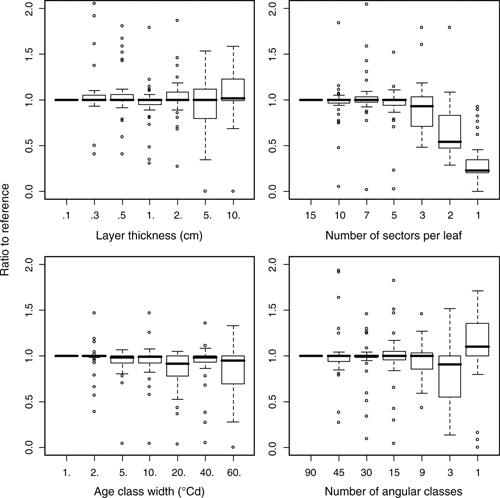Coupling a 3D virtual wheat (Triticum aestivum) plant model with a Septoria tritici epidemic model (Septo3D): a new approach to investigate plant–pathogen interactions linked to canopy architecture
Corinne Robert A B E F , Christian Fournier C D E , Bruno Andrieu A B and Bertrand Ney A BA INRA, UMR 1091 EGC, F-78850 Thiverval-Grignon, France.
B AgroParisTech, UMR 1091 EGC, F-78850 Thiverval-Grignon, France.
C INRA, UMR 759 LEPSE, 2 place Viala, F-34060 Montpellier Cedex 01, France.
D SupAgro, UMR 759 LEPSE, 2 Place Viala, F-34060 Montpellier, France.
E These authors contributed equally to the work.
F Corresponding author. Email: corinne.robert@grignon.inra.fr
This paper originates from a presentation at the 5th International Workshop on Functional–Structural Plant Models, Napier, New Zealand, November 2007.
Functional Plant Biology 35(10) 997-1013 https://doi.org/10.1071/FP08066
Submitted: 8 March 2008 Accepted: 11 September 2008 Published: 11 November 2008
Abstract
This work initiates a modelling approach that allows us to investigate the effects of canopy architecture on foliar epidemics development. It combines a virtual plant model of wheat (Triticum aestivum L.) with an epidemic model of Septoria tritici which is caused by Mycosphaerella graminicola, a hemi-biotrophic, splashed-dispersed fungus. Our model simulates the development of the lesions from the infected lower leaves to the healthy upper leaves in the growing canopy. Epidemics result from the repeated successions of lesion development (during which spores are produced) and spores dispersal. In the model, canopy development influences epidemic development through the amount of tissue available for lesion development and through its effects on rain penetration and droplets interception during spore dispersal. Simulations show that the impact of canopy architecture on epidemic development differs between canopy traits and depends on climate. Phyllochron has the strongest effect, followed by leaf size and stem elongation rate.
Additional keywords: disease escape, epidemic model, L-system, Mycosphaerella graminicola, plant–pathogen interaction, cv. Soissons, Triticum aestivum, 3D virtual plant model.
Acknowledgements
We thank three anonymous reviewers for their constructive comments. This work was funded by the INRA department of Environnement et Agronomie and by Casdar project No. 6128. We thank Julie Rodriguez for processing data of lesions growth and Jessica Bertheloot for providing us data to parameterise tillering and senescence in ADEL.
Atkinson D, McKinlay RG
(1997) Crop protection and its integration within sustainable farming systems. Agriculture Ecosystems & Environment 64, 87–93.
| Crossref | GoogleScholarGoogle Scholar |
simulates the development of the plant by application of L-System productions, very much like the ones used in ADEL;
Table 2 updates the global variables describing the canopy and computes dispersal. It screens all plant modules, calculates their position in space (similarly to an interpretation step), and uses this information to update (i) the orientation and position of all phyto-element within the layers, and (ii) the localisation and potential of spore production of sporulating areas. After Table 2, in the EndEach paragraph, the dispersal sub-routine is called as many times as there is rain events and stores its outputs in the global variable;
Table 3 processes similarly to Table 2 for screening and positioning modules, but uses this information to retrieve, for each leaf sector, the variables computed by the dispersal subroutine: the number of droplets (DU) splashed by rains and new ones intercepted;
Table 4 simulates the development of lesions within leaf sectors, by calling within productions and for each leaf sector the routines of the lesion development model.
Optimisation of numeric discretisations
In the model implementation four principal discretisations have been introduced to represent continuous systems: the division of leaves into sectors, the grouping of lesions into cohorts, the division of canopy surfaces into layers and the division of the directions of emission of droplets into angular classes. This allows finding with simulations, the degree of precision needed to represent coherently the system, whilst optimising computing times. To perform this optimisation, we simulates for four contrasting scenarios an indicator of disease severity at leaf level, and searched for the coarser level of discretisation that leaves unchanged the results of a reference simulation with a fine level of discretisation. For the number of sectors, simulations results are significantly altered and unstable when less than five sectors are used (Fig. A1), which corresponds to sector area of 2–5 cm2. Increasing layer thickness or age class width (maximal difference of ages between lesions of a cohort) does not introduce a general bias in the model, but alters the results at the level of individual leaves, as indicated by the increase of the box height (Fig. A1). Stability of the results occurs for thickness below 2 cm, and age class width below 10°Cd, that roughly corresponds to the mean duration of a time step during winter. The optimal number of angular classes is 15, which corresponds to a 6° wide angle.

|


